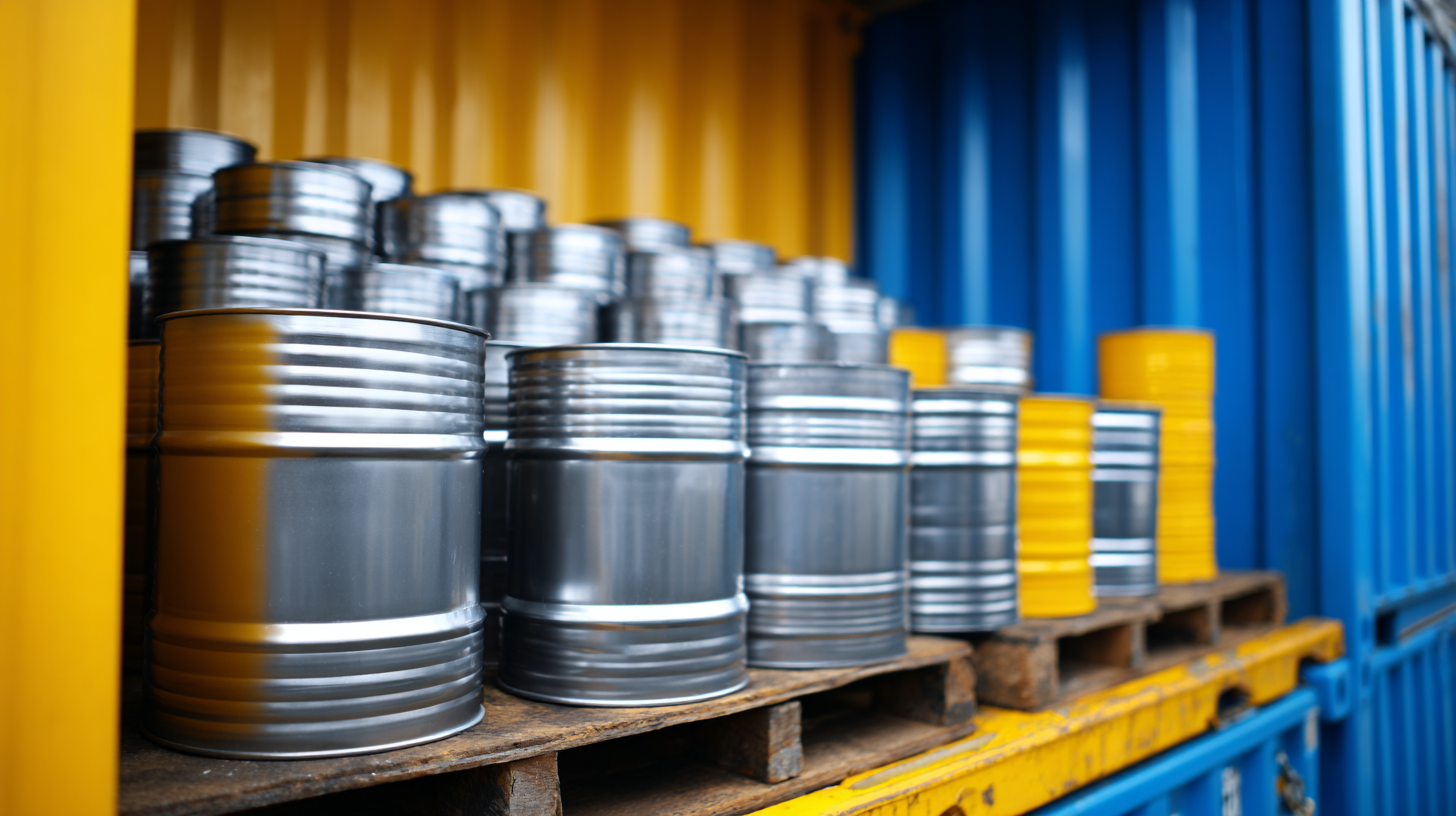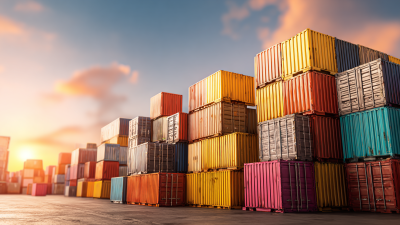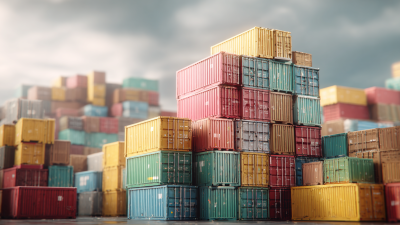Innovative Container and Packaging Solutions Revolutionizing Sustainable Practices
The container and packaging industry has undergone a significant transformation in recent years, driven by the urgent need for sustainable practices. With global plastic production expected to reach 1.5 billion metric tons by 2030, the emphasis on innovative and eco-friendly packaging solutions is more pressing than ever. According to a report by Smithers Pira, the global environmentally friendly packaging market is projected to be worth $500 billion by 2027, indicating a strong shift towards sustainable container and packaging solutions.

These innovative approaches not only address environmental concerns but also enhance brand reputation and consumer loyalty. As per a recent survey by Nielsen, 73% of global consumers are willing to pay a premium for sustainable brands, highlighting the growing demand for responsible container and packaging options. Companies are now adopting advanced materials such as biodegradable plastics and recycled content to align with customer preferences and regulatory requirements.
The integration of cutting-edge technology in container and packaging design further accelerates this revolution. From smart packaging that improves product safety to minimalistic designs that reduce material usage, the sector is poised for a remarkable evolution. As businesses strive to meet sustainability goals, the container and packaging industry stands at the forefront of this critical movement, paving the way for a greener future.
Innovative Materials: Biodegradable Plastics Leading the Change in Packaging
The rise of biodegradable plastics is a transformative force in the packaging industry, particularly as businesses face mounting pressures to adopt sustainable practices. Recent news indicates a growing urgency in this movement, especially reflected in California's new labeling regulations, which could significantly impact manufacturers of compostable products. As companies strive to navigate these challenges, they recognize that the integration of biodegradable materials not only addresses consumer demand for eco-friendly options but also aligns with global initiatives aimed at reducing plastic waste.
New regulations across Asia are compelling businesses to assume greater responsibility for their packaging. This shift has led to an increased adoption of biodegradable and recyclable materials, with reports suggesting that bioplastics could account for up to 20% of the total plastics market by 2025. Innovations in packaging technologies, including smart sensors and compostable bioplastics, are emerging as key solutions to mitigate environmental impacts. The momentum behind these materials is not merely a trend; it reflects a significant change in consumer behavior and regulatory landscapes, demonstrating a collective commitment to sustainability within the industry.
Smart Packaging Technologies: Enhancing Shelf Life and Reducing Waste
Smart packaging technologies are emerging as game changers in the pursuit of sustainability within the food and beverage industry. These innovative solutions not only enhance the shelf life of products but also play a critical role in reducing waste. By incorporating sensors and indicators, smart packaging can actively monitor freshness, temperature, and humidity, providing consumers with real-time information about the lifecycle of the product. This transparency not only empowers consumers to make informed choices but also encourages manufacturers to adopt more sustainable practices, ultimately leading to a significant decrease in spoilage and waste.
Furthermore, these advanced technologies often utilize eco-friendly materials and designs that prioritize recyclability and biodegradability. For instance, packaging that incorporates bio-based polymers or easily recyclable materials aligns with global initiatives to minimize plastic waste and reduce reliance on fossil fuels. By leveraging smart packaging, companies can not only improve their sustainability metrics but also enhance consumer engagement through interactive features that promote recycling and responsible disposal. As these innovations continue to develop, they are set to redefine industry standards and contribute significantly to a more sustainable future.
Innovative Container and Packaging Solutions Impacting Sustainability
This chart illustrates the effectiveness of different smart packaging technologies in enhancing shelf life and reducing waste, highlighting their importance in sustainable practices.
Circular Economy: How Reusable Containers are Transforming Supply Chains
The transition towards a circular economy has been significantly influenced by the adoption of reusable containers, which are not only enhancing sustainability but also streamlining supply chains. According to a report by the Ellen MacArthur Foundation, transitioning to reusable packaging can reduce packaging waste by up to 70%, which is critical as the global plastic packaging market is projected to reach $1 trillion by 2027. Companies are increasingly recognizing that implementing sustainable packaging solutions not only boosts their brand image but also leads to cost savings in the long run.
Moreover, a study conducted by Accenture revealed that 57% of consumers are willing to change their shopping habits to reduce environmental impact. This shift in consumer behavior is prompting businesses to integrate reusable systems within their operations. For instance, major retailers are now investing in deposit return schemes and reusable tote programs that encourage customers to return containers after use, thus minimizing single-use packaging. Such practices not only reduce the environmental footprint but also help companies achieve greater efficiency in their supply chains, creating a win-win situation for both businesses and consumers.
Innovative Container and Packaging Solutions Revolutionizing Sustainable Practices - Circular Economy: How Reusable Containers are Transforming Supply Chains
| Dimension | Description | Impact on Supply Chain |
|---|---|---|
| Reusable Containers | Containers designed for multiple uses, reducing waste. | Lower logistics costs and decrease in packaging waste. |
| Material Innovation | Use of biodegradable and recycled materials. | Minimizes environmental footprint and promotes sustainability. |
| Tracking Technology | RFID and IoT technologies for tracking usage and returns. | Enhances efficiency in inventory management. |
| Logistics Collaboration | Partnerships between suppliers and retailers for container sharing. | Reduces costs and improves turnaround times. |
| Consumer Involvement | Encouragement of customers to return containers for reuse. | Enhances recycling rates and customer engagement. |
Consumer Preferences: The Shift Towards Sustainable Packaging Options
As consumers become increasingly aware of environmental issues, there is a significant shift towards
sustainable packaging options. This transformation is not just a trend; it reflects a deeper understanding
of the impact packaging has on the environment. Today’s consumers are seeking products that not only meet
their needs but also minimize ecological footprints. From biodegradable materials to reusable containers,
brands that embrace these innovations are winning the loyalty of
eco-conscious shoppers.
Tips for Choosing Sustainable Packaging:
- Look for Certifications: Seek products with recognized eco-labels such as FSC or biodegradable certifications to ensure responsible sourcing and production.
- Prioritize Functionality: Opt for designs that not only reduce waste but also enhance user experience. Multi-use packaging can be a great way to reduce clutter and promote sustainability.

Regulatory Impacts: How Legislation is Driving Innovation in Packaging Solutions
 The emergence of stringent regulations worldwide is significantly driving innovation in packaging solutions. As governments increasingly focus on sustainability, standards such as the European Union’s Single-Use Plastics Directive have set ambitious targets for reducing plastic waste. According to a report by the Ellen MacArthur Foundation, transitioning to circular packaging systems could potentially yield $1 trillion in economic benefits and drastically reduce carbon emissions associated with packaging. This legislative push not only fosters the development of biodegradable materials but also encourages research into reusable and recyclable packaging options that meet regulatory requirements.
The emergence of stringent regulations worldwide is significantly driving innovation in packaging solutions. As governments increasingly focus on sustainability, standards such as the European Union’s Single-Use Plastics Directive have set ambitious targets for reducing plastic waste. According to a report by the Ellen MacArthur Foundation, transitioning to circular packaging systems could potentially yield $1 trillion in economic benefits and drastically reduce carbon emissions associated with packaging. This legislative push not only fosters the development of biodegradable materials but also encourages research into reusable and recyclable packaging options that meet regulatory requirements.
When considering sustainable packaging, companies are advised to stay ahead of the curve by proactively engaging with evolving regulations. Implementing a robust compliance strategy can facilitate a smoother transition to innovative practices. One effective tip is to invest in materials that conform to regulatory standards early in the product development process. This not only mitigates risks associated with non-compliance but also positions companies as leaders in sustainability, attracting eco-conscious consumers.
Additionally, businesses can leverage technology to optimize their packaging processes. Utilizing data analytics and AI can streamline production efficiency and help in selecting materials that align with sustainability goals. This strategic integration of technology in response to regulatory impacts not only enhances packaging solutions but also reflects a company's commitment to sustainable practices.
Related Posts
-

Ultimate Guide to Organizing Your Kitchen with Stylish Spice Bottles
-

The Amazing Health Benefits of Honey Bottles You Never Knew About
-

Innovative Trends in Container and Packaging Solutions Driving Sustainability and Reducing Waste
-

What are the Benefits of Using Eco-Friendly Cosmetic Containers
-

Innovative Designs in Cosmetic Containers Elevating Your Beauty Brand Aesthetic
-

Exploring Sustainable Innovations in Container and Packaging Supply for a Greener Future
